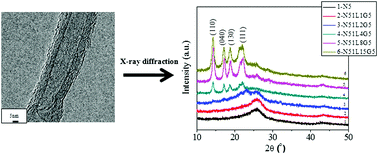Role of interfacial interactions to control the extent of wrapping of polymer chains on multi-walled carbon nanotubes†
Abstract
A novel method has been developed to establish an enhanced interfacial interaction between polypropylene (PP) and multi-walled carbon nanotubes (MWCNTs) via interfacial engineering. MWCNTs were separated via a hot vacuum filtration technique from a melt-mixed PP/MWCNTs composite containing pristine MWCNTs or the Li-salt of 6-amino hexanoic acid (Li-AHA) modified MWCNTs with a polymeric compatibilizer (polypropylene-g-maleic anhydride; PP-g-MA). Transmission electron microscopic observation suggested the presence of thicker polymer wrapping on the MWCNT surface. Various spectroscopic techniques; viz.; solid state nuclear magnetic resonance spectroscopy, Fourier transform infrared spectroscopy and Raman spectroscopy could unequivocally support the presence of adhered PP chains on the MWCNT surface. Further, differential scanning calorimetry and wide angle X-ray diffraction analysis suggested the presence of the crystallizable PP chains on the MWCNT surface. Thermo-gravimetric analysis showed an increase in the residual weight at 500 °C for the separated MWCNT indicating the formation of an ‘interphase’. A decrease in the DC electrical conductivity was observed in the compacted pellet of the separated MWCNTs of the Li-AHA modified MWCNTs with PP-g-MA indicating the presence of insulating polymer chains on the MWCNT surface. The role of interfacial interactions in the formation of the ‘interphase' was demonstrated via various characterization techniques.


 Please wait while we load your content...
Please wait while we load your content...